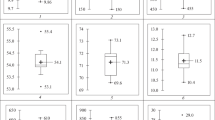Summary
Seeds of some cowpea varieties, characterized by different degrees of storage pest resistance, were analyzed for inhibitors of the following enzymes: porcine amylase, Bacillus amylase, bovine chymotrypsin and trypsin. A broad variation was observed among samples for all tested inhibitors. Submitting the experimental data to the principal component analysis it has been observed that resistant lines are characterized by high levels of both antitryptic and antiamylasic activity. Moreover a high activity of a single inhibitor class is typical of the bruchid susceptible lines. Hence, breeding for high contents of these protein inhibitors could be an effective way of obtaining lines that are naturally resistant to storage pest attack. The limit of this breeding strategy seems to be the difficulty to reduce the antiamylasic activity before eating.
Similar content being viewed by others
References
AOAC, 1970. Official methods of analysis, eleventh ed., Association of official agricultural chemists, Washington, DC.
Baker, T.A., S.S., Nielsen, R.E., Shade & B.B., Singh, 1989. Physical and chemical attributes of cowpea lines resistant and susceptible to C. maculatus (coleoptera: bruchidae). J. Stored Prod. Res. 25: 1–8.
Buonocore, V. & V., Silano, 1986. Biochemical, nutritional and toxicological aspects of α-amylase inhibitors from plant foods. In: M., Friedman (Ed.). Nutritional and toxicological significance of enzyme inhibitors in foods, pp. 483–507. Plenum Press, New York.
Caswell, G.H., 1981. Damage to stored cowpea in the northern part of Nigeria. Samaru J. Agric. Res. 1: 11–19.
Della Gatta, C., A.R., Piergiovanni & P., Perrino, 1988. An improved method for the determination of trypsin inhibitor levels in legumes. Lebensm. Wiss. Technol. 21: 315–318.
Erlanger, B.F., E., Frances & A.G., Cooper, 1966. The action of chymotrypsin on two new chromogenic substrates. Arch. Biochem. Biophys. 115: 206–210.
Gatehouse, A.M.R. & D., Boulter, 1983. Assessment of the antimetabolic effects of trypsin inhibitors from cowpea (Vigna unguiculata) and other legumes on development of the bruchid beetle C. maculatus. J. Sci. Food Agric. 34: 345–350.
Gatehouse, A.M.R., F.M., Dewey, J., Dove, K.A., Fenton & A., Pusztai, 1984. Effect of seed lectins from Phaseolus vulgaris on the development of larvae of C. maculatus: mechanism of toxicity. J. Sci. Food Agric. 35: 373–380.
Gatehouse, A.M.R., K.A., Fenton, I., Jepson & D.J., Pavey, 1986. The effects of α-amylase inhibitors on insect storage pests: inhibition of α-amylase in vitro and effects on development in vivo. J. Sci. Food Agric. 37: 727–734.
Gupta, Y.P., 1987. Antinutritional and toxic factors in food legumes: a review. Plant Foods Hum. Nutr. 37: 201–228.
Laskowski, M. & I., Kato, 1980. Protein inhibitors of proteinases. Ann. Rev. Biochem. 49: 593–626.
Liener, I.E. & M.L., Kakade, 1980. Protease inhibitors. In: I.E., Liener (Ed.). Toxic constituents of plant foodstuffs, Academic Press, New York.
Murdock, L.L., R.E., Shade & M.A., Pomeroy, 1988. Effects of E-64 a cysteine proteinase inhibitor on cowpea weevil growth, development and fecundity. Environ. Entomol. 17: 467–469.
Piergiovanni, A.R., 1992. Effects of some experimental parameters on the activity of cowpea α-amylase inhibitors. Lebens. Wiss. Technol. 25: 321–324.
Piergiovanni, A.R. & C. Della, Gatta, 1994. Alpha-amylase inhibitors in cowpea (Vigna unguiculata): effects of soaking and cooking methods. Food chem. 51: 79–81.
Piergiovanni, A.R., G., Sonnante, C. Della, Gatta & P., Perrino, 1991. Digestive enzyme inhibitors and storage pest resistance in cowpea (Vigna unguiculata) seeds. Euphytica 54: 191–194.
Rackis, J.J., W.J., Wolf & E.C., Baker, 1986. Protease inhibitors in plant foods: content and inactivation. In: M., Friedman (Ed.), Nutritional and toxicological significance of enzyme inhibitors in foods, pp. 299–347. Plenum Press, New York.
Richardson, M., 1980. Protein inhibitors of enzymes. Food Chem. 6: 235–253.
SAS Institute Inc., 1987. SAS Application Guide, 1987 edition, SAS Institute Inc., Cary, North Carolina.
Singh, B.B., S.R., Singh & O., Adjadi, 1985. Bruchid resistance in cowpea. Crop Science 25: 736–739.
Singh, S.R., L.E.N., Jackai, J.H.R. Dos, Santos & C.B., Adalla, 1990. Insect pests of cowpea. In: S.R., Singh (Ed.). Insect pests of tropical food legumes, pp. 43–89. John Wiley and Sons, Chichester.
Xavier-Filho, J., F.A.P., Campos, M.B., Ary, C. Peres, Silva, M.M.M., Caravalho, M.L.R., Macedo, F.J.A., Lemos & G., Grant, 1989. Poor correlation between the levels of proteinase inhibitors found in seeds of different cultivars of cowpea (Vigna unguiculata) and the resistance/susceptibility to predation by C. maculatus. J. Agric. Food Chem. 37: 1139–1143.
Author information
Authors and Affiliations
Rights and permissions
About this article
Cite this article
Piergiovanni, A.R., Gatta, C.D., Sergio, L. et al. High antinutrient levels and bruchid resistance of cowpea (Vigna unguiculata) seeds. Euphytica 80, 59–62 (1994). https://doi.org/10.1007/BF00039298
Received:
Accepted:
Issue Date:
DOI: https://doi.org/10.1007/BF00039298




